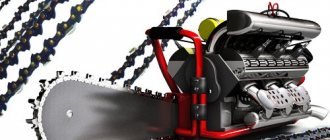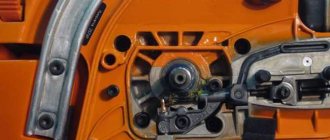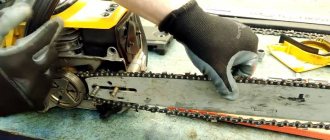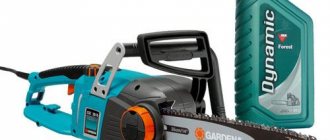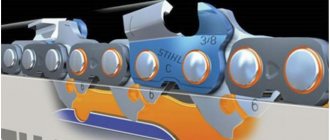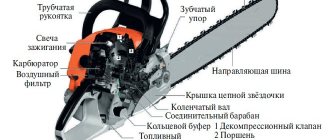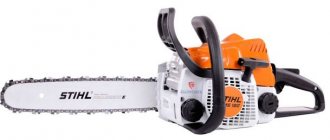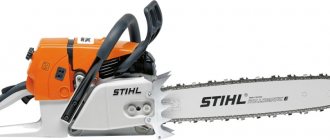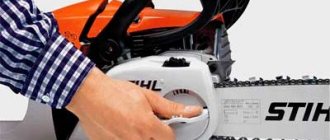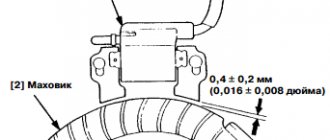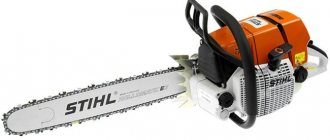Scope of application
A carbide chain is well suited, and sometimes simply irreplaceable, for sawing hard and super-hard wood. For example:
- bog oak;
- steamed wood, similar in density to bone;
- hardwood of the first cut (from a stump), butt, especially dry and twisted (with twisted fibers);
- dry wood with strong branches;
- wood with ice on the surface or contaminated with sand or soil.
Chainsaws with carbide chains are used for cutting ice for any need, including for creating ice sculptures.
Rescue teams from the Ministry of Emergency Situations routinely use only this type of cutting set, even when they have to clear debris made from ordinary wood. In extreme situations, there is no time to monitor the safety of the chain. Often the cutting edge touches stone, the ground, or metal gets into wood. A regular chain will instantly fail and require replacement, but during an emergency there is no time for this.
Victory chain design
The pobedite chain consists of 3 types of links:
- cutting, a tooth is attached to them;
- leading, their lower part (fang) slides along the groove in the tire;
- figure-eight connecting plates.
These parts are connected to each other with rivets.
The cutting link, in addition to the tooth (cutter) itself, has a protrusion that limits the depth of cut.
That is, a pobedit chain does not differ from a regular one in any way, except for other qualities of the alloy of the cutting edge of the teeth.
How it works
The winner is a difficult-to-manufacture and expensive material. Therefore, not the entire tooth is made from it, but only the cutting edge. It is soldered to the body of the teeth using a copper alloy. Despite the softness of copper, such solders are quite strong and, as a rule, last their entire service life.
On pobedite chains, manufacturers do not use soldering, but make the entire cutting link from carbide.
Design Features
Pobedite chains perform better on more powerful than average chainsaws with high traction force. An ordinary tooth can be compared to a sharply sharpened blade. When it becomes dull, the sharpness can be easily restored by straightening the tooth with a special round file with a stencil for maintaining the angle. The pobedite tooth dulls slowly and imperceptibly. Even if slightly dull, it can still work well for a long time. But then more traction on the chainsaw is required, at least 3-3.5 hp.
What are the teeth made of?
A real winner is made using powder metallurgy technology and consists of 90% tungsten carbide and 10% cobalt with a small admixture of carbon. Tungsten and cobalt powder are pressed and then sintered at high temperatures close to melting the metal. Available in the form of plates, often already of a given shape.
The material was created in 1929, and since then, on its basis and according to its principle, many different materials have been created - VK4, VK6, VK8, VK10, T15K6, including those specifically for sawing wood.
Tools required for work
When starting riveting, the first thing you need to do is remove the link from the chain; for this you will need to rivet the rivets. For riveting, you will need an anvil, a hammer, a thin bit, a vice, a grinder with a grinding wheel or emery cloth. These tools do not allow for quality work, but everyone has them. A more cultured and gentle way is to remove the rivets using a special punch.
There are several designs of punches; we’ll tell you about the most popular.
Rivet punch
A punch is a machine that is used to remove rivets.
It is mechanical and works on the principle of a press. The kit includes a special anvil, in which grooves are selected for installing the headset with different pitches. There are also replaceable tips with which the rivets are extruded.
We invite you to watch a video that shows how to rivet a saw chain using a mechanical punch.
After the chain is riveted, it is necessary to remove the old link, install a new one and rivet it. For this purpose, a riveting-rolling machine is used. It is electric, so it costs much more than a punching machine.
Riveting and rolling machine
The machine is equipped with a gear motor with high torque.
Used for riveting and rolling headsets in increments from 1/4″ to 0.404″. The cutting depth of chains that can be riveted using this machine is from 1.1 mm to 2 mm (0.043″ - 0.080″). Special rotating inserts and anvils for different types are supplied with the machine. Inserts and anvils are marked. Marking “A” means that the inserts are designed for a headset with a pitch of 3/8″ and 0.404″. “B” is for 1/4″ and 0.325″.
The machine works as follows. The saw chain with a new link and rivets is installed in the guide inserts. The repair link with the rivets installed in it is pressed by the working roller against the anvil, after which the engine is turned on and the roller begins to rotate, gradually crushing the rivet, at this moment the machine operator slightly increases the pressing force of the roller by tightening the adjusting screw. For clarity, we suggest watching a video about the operation of a riveting-rolling machine.
It is not profitable to use such a machine for riveting houses, because it is expensive. If you do not need to rivet regularly, you can do without it. Let's look at how to shorten a chainsaw chain with your own hands without using expensive machines. You need to start by riveting and removing the link.
The advantage of the machine is that the rivets riveted with its help are practically no different in quality from those riveted in the factory.
Overview of circuits with pobeditovy soldering
Unlike saw blades, until now, chains with pobedit tips have not become widespread. Neither for domestic use nor in the logging industry. Even powerful chains for harvesters - forestry machines, from fellers to loppers - most often do not have pobedit inserts.
It is important that you should not confuse wood chains with chains for gas cutters for other purposes. For example, today there are diamond-coated chains on sale that are structurally, in size and externally similar to wood chains. They are designed for cutting brick, concrete and even metal. But they are not suitable for chainsaws in terms of pitch, thickness and length, and cannot cut wood. The wood simply smokes and burns from friction, as if drilled with a Pobedit drill.
Repair and maintenance of chainsaw chains
Repairing this structural part of a power tool is usually not very difficult. Its features, as well as maintenance requirements, are outlined in the user manual for the saw itself.
Important:
- adhere to operating rules;
- periodically monitor the degree of chain tension;
- sharpen cutting edges.
The last circumstance can be omitted due to the fact that a certain part of the new models is self-sharpening.
Together with original spare parts, repairing cutting chains has long ceased to be a problem. And it doesn’t matter whether you plan to replace the drive roller or sprocket.
It is definitely not possible to say which chain for a chainsaw is better. After all, the range of chains, as well as the requirements put forward by customers, are constantly changing.
Diamond and pobedite chainsaw chains are in great demand, as they make high-quality cuts not only on wood, but also on concrete, aerated concrete, brick and other material structures. Despite the high price and rather complex maintenance cycle, carbide chains are increasingly becoming the choice of professionals. After all, a chain with pobedit tips is not afraid of any contamination and will easily cut through metal parts - nails, shavings, which often get in the way of the cut
When deciding to buy a new chain, you need to understand one thing - a high price is not always a guarantee of quality. In addition, it is precisely these paintings that are most often counterfeited. Therefore, it is better to purchase an original headset directly in the store, checking the documentation accompanying the product and the availability of a warranty card.
Somehow I got a new Oregon chain for Husqvarna-140. It’s a good thing, I decided, and put it away until better times. And when the time came to change the old one, it turned out that the chain did not fit on the chainsaw, although in all respects it corresponded to the previous one. By the same token as the chain, I also got a new 16" tire. With this tire and chain, I rushed to the store, hoping to figure out what was what with the help of experienced salespeople...
We figured it out. It turned out that the hands had a shortened chain for a chainsaw.
The new chain has 55 teeth, while the old one has 56. And it is not long enough to be thrown over the tire sprocket. The seller said that there is a special type of tire for such chains and, naturally, they are not on sale now. When asked what to do, he suggested adapting the old tire to the new chain yourself. Those. The chainsaw bar requires a little modification. It only takes about 5 minutes to cut off the heel a little so that the tire, without resting on the sprocket, rolls back to a distance sufficient to put on the shortened chain.
On the first fine day I gather my beloved, saw and grinder in one place
Using the allen key that comes with the saw, I remove the cover to fit the new chain to the old bar, and I realize that simply cutting the tail will not be enough.
The photographs clearly show that the length of the longitudinal groove on the bar with a shortened chain is also not enough, which means it will have to be lengthened. I used a red marker to indicate what would need to be removed on the tire.
In principle, indeed, it took a little more than five minutes, and that’s because after using the grinder I decided to smooth the edge a little with a file
Already anticipating the sky-high performance of the saw with the new chain, I put everything in place. I won’t say it’s easy, but the tire becomes, and the chain is put on and rotates freely. But when I try to put the cover back in place, I come across another “unexpected thing” - even the chain tensioner finger, moved to the extreme left, does not reach its groove in the tire.
Well, that means a new hole should be made, a little closer. As we were taught - first with a small diameter drill, then a larger diameter, low speed, so as not to overheat the drill...
The hole turned out neat and, what is no less surprising, even in the right place. Moreover, there is a power reserve.
In general, I assembled the saw, made sure that everything that should move... moves, and without interference or friction, added chain oil and fuel mixture and started my Husqvarna. Nothing unusual happened - the saw started up easily and just as easily (40.9 cm?, and with a new chain) dug into the trunk offered to it.
Great, we can use firewood.
7, total, today
Which winning chain to choose for your home
However, recently new chains with carbide cutters have appeared on sale, which we have always called and will continue to call Pobedit. Moreover, specifically for household and semi-professional chainsaws. These are Rapid Duro 3 chains, manufactured by STIHL in Switzerland. The chains are without soldering, the entire cutting link is entirely made of hard alloy.
Specifically, these are the chains:
- STIHL 63PD-56E 16 inches long, 1.3 mm thick.
- STIHL 63PD-50E 14 inches long, 1.3 mm thick.
- STIHL Picco Duro 3/8-1.3-57 is the world's first carbide version of a low-profile chain.
Despite the fact that these chains have appeared quite recently, there is already experience in their use. These chains today cost 4-5 times more expensive than regular ones, from 1600 to 2000 rubles. According to reviews, they last about the same number of times longer than usual without sharpening.
For information on the rules for selecting a carbide (pobedite) chain for a specific chainsaw, see the following video:
Step-by-step installation algorithm
Not all modern chainsaws are equipped with an installation wheel, which significantly simplifies the procedure for installing the saw blade. Systems with an adjustment wheel are generally rare among household chainsaws.
Therefore, it is very important to know the technology and sequence of installing a chain on a chainsaw
Key points to note:
- Prepare a flat surface on which you will assemble the chain and bar. This will minimize the chance of damage to the chainsaw or loss of small parts. A tire is laid out on the prepared surface and a chain next to it in parallel.
- Remove the sprocket guard, on modern chainsaws it is enough to unscrew the wing nut, on older models you may need a spanner of the appropriate size.
- At the base of the guide bar, turn the tension sprocket all the way to the right. Only in this position is the chain installed.
- Then the chain is placed sequentially, link by link, onto the locking groove on the guide bar. Install the chain from the top of the guide, gradually turn it so that the bar is always on top and the chain is on the bottom, this will allow it to always be taut and fit into the guide groove without problems. When performing this step, be sure to wear thick protective gloves, because your fingers will touch the cutting edge. If you look from above, the cutter is always located forward towards the end of the guide bar.
- Place both the bar and chain on the drive sprocket.
- Secure the chain sprocket cover in place. Make sure all mounting pins line up with the holes. Incorrect installation with distortions or not completely can cause extraneous noise and rattling.
- Make sure that the guides fit into the special mounting groove.
- After installation, check that the chain is secure on the chainsaw and on the bar. Everything should be securely fastened without any backlash.
An important point is the degree of chain tension after installation. Setting the correct tension is very simple and takes no more than three minutes. First you need to loosen the nuts on the protective cover. Using a freely rotating adjusting screw, set the correct tension so that the chain does not pull more than 3-5 mm from the edge of the guide bar.
All that remains is to tighten the nuts and check the tension. If adjustment is necessary, adjust the tension again.
How to install a bar and chain on a chainsaw, see the following video, which presents a clear algorithm of actions:
Ways to check the degree of tension
Checking the tension level is important, as the consequences of incorrect adjustment can be fatal for the sawyer. The quality of chain tension adjustment can be determined by:
- When moving the product manually, it should not jam or show signs of difficulty in its movement.
- The cutting element must be checked for looseness by grasping the link and trying to pull it up. The normal tension value should correspond to the exit of the shanks from the tire (in its middle) of no more than 2/3.
- When moving the device, there should be no creaks or other extraneous noise.
In conclusion, it should be noted that you should never adjust the chain while it is hot, as this will certainly lead to a number of negative consequences. As a result of such actions, it may be necessary to replace not only the tire and chain, but also the drive sprocket.
Pobedite chain for professional work
For professional chainsaws, manufacturers still offer chains with old alloys, which are commonly called “quick cutters”. Knives for planes are made from similar alloys, and old circular saws were made without carbide tips.
The new carbide chains from STIHL listed above are 1.3mm thick, which is the same as for household and semi-professional chainsaws. The production of such chains with a thickness of 1.5 mm and higher for powerful chainsaws has not yet begun.
However, high-speed alloys have different compositions and qualities. And for professional chains, they are stronger and more durable by default. As a rule, it is enough to have a replacement set of 2-3 spare sharpened chains and a file for straightening, and no special problems arise even with large volumes of work.
Refurbishment of carbide chains
Early adopters of carbide chains found that they dulled over time, although at a much slower rate.
Then the problem arises - how to sharpen a hard alloy that a conventional file cannot handle. An ordinary sharpening disc on a special machine will not sharpen it either, so today not every service center can sharpen such a chain. And if they can, then it is expensive.
Therefore, along with the purchase of such a chain, it is better to immediately buy a diamond blade for sharpening. A diamond-coated aluminum disc with a thickness of about 10 mm is suitable for a conventional electric sharpener.
You can also sharpen carbide alloys with a diamond disc on a regular angle grinder (grinder) using homemade fasteners and guides.

